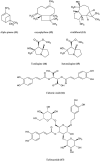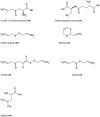Plant Derived Immunomodulators; A Critical Review
- PMID: 36415638
- PMCID: PMC9675921
- DOI: 10.34172/apb.2022.074
Plant Derived Immunomodulators; A Critical Review
Abstract
The concept of immunomodulation was proposed by Edward Jenner, while working on polio vaccine in 1796. Many of the autoimmune diseases such as rheumatoid arthritis, inflammatory bowel diseases, psoriatic arthritis and system lupus erythematosus, viral diseases and, some cancers are characterized with elevated levels of "immunocytokine" gene expression, including, tumor necrosis factor-α, various interleukins, cytotoxic T-cell antigen-4, B-cell activating factor. For the treatment of these diseases, the immunologically-based therapies play the major role. In these lines, the usage of phytomedicines as immunostimulants/ immunosuppressants have been enhanced considerably in last few decades and also used as a prophylactic treatment for various ailments. Phytochemicals such as flavonoids, terpenoids, polysaccharides, lactones, alkaloids, glycosides and saponins present in several plants, have been confirmed to exhibit immunomodulating properties. This review focuses on the traditional plants and their constituents which have been extensively used as immunomodulators. We have also highlighted the mechanism of action of these plant constituents related to autophagy and adjuvanticity of drugs.
Keywords: Immunomodulators; Immunostimulants; Immunosuppressants; Traditional plants.
©2022 The Authors.
Conflict of interest statement
The authors report no conflict of interest.
Figures
References
-
- Delves PJ, Martin SJ, Burton DR, Roitt IM. Roitt›s Essential Immunology. John Wiley & Sons; 2017.
-
- Kindt TJ, Goldsby RA, Osborne BA, Kuby J. Kuby Immunology. Macmillan; 2007.
Publication types
LinkOut - more resources
Full Text Sources












